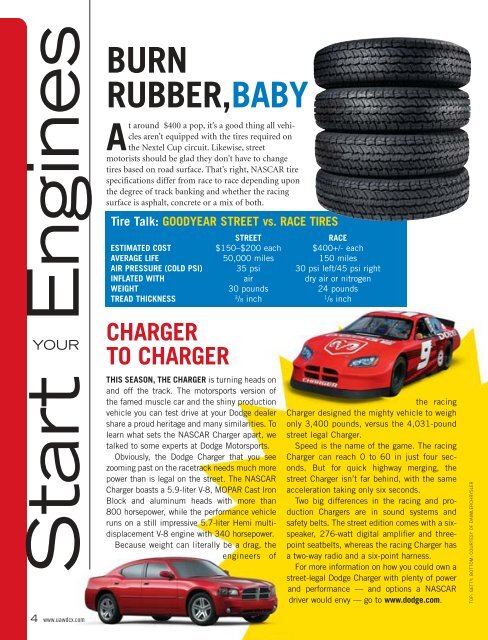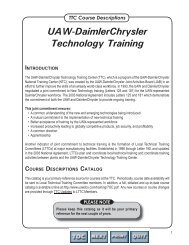You also want an ePaper? Increase the reach of your titles
YUMPU automatically turns print PDFs into web optimized ePapers that Google loves.
Start Engines<br />
YOUR<br />
BURN<br />
RUBBER,BABY<br />
At around $400 a pop, it’s a good thing all vehicles<br />
aren’t equipped with the tires required on<br />
the Nextel Cup circuit. Likewise, street<br />
motorists should be glad they don’t have to change<br />
tires based on road surface. That’s right, NASCAR tire<br />
specifications differ from race to race depending upon<br />
the degree of track banking and whether the racing<br />
surface is asphalt, concrete or a mix of both.<br />
Tire Talk: GOODYEAR STREET vs. RACE TIRES<br />
STREET<br />
RACE<br />
ESTIMATED COST $150–$200 each $400+/- each<br />
AVERAGE LIFE 50,000 miles 150 miles<br />
AIR PRESSURE (COLD PSI) 35 psi 30 psi left/45 psi right<br />
INFLATED WITH air dry air or nitrogen<br />
WEIGHT 30 pounds 24 pounds<br />
TREAD THICKNESS 3<br />
/8 inch 1<br />
/8 inch<br />
CHARGER<br />
TO CHARGER<br />
THIS SEASON, THE CHARGER is turning heads on<br />
and off the track. The motorsports version of<br />
the famed muscle car and the shiny production<br />
vehicle you can test drive at your Dodge dealer<br />
share a proud heritage and many similarities. To<br />
learn what sets the NASCAR Charger apart, we<br />
talked to some experts at Dodge Motorsports.<br />
Obviously, the Dodge Charger that you see<br />
zooming past on the racetrack needs much more<br />
power than is legal on the street. The NASCAR<br />
Charger boasts a 5.9-liter V-8, MOPAR Cast Iron<br />
Block and aluminum heads with more than<br />
800 horsepower, while the performance vehicle<br />
runs on a still impressive 5.7-liter Hemi multidisplacement<br />
V-8 engine with 340 horsepower.<br />
Because weight can literally be a drag, the<br />
engineers of<br />
the racing<br />
Charger designed the mighty vehicle to weigh<br />
only 3,400 pounds, versus the 4,031-pound<br />
street legal Charger.<br />
Speed is the name of the game. The racing<br />
Charger can reach 0 to 60 in just four seconds.<br />
But for quick highway merging, the<br />
street Charger isn’t far behind, with the same<br />
acceleration taking only six seconds.<br />
Two big differences in the racing and production<br />
Chargers are in sound systems and<br />
safety belts. The street edition <strong>com</strong>es with a sixspeaker,<br />
276-watt digital amplifier and threepoint<br />
seatbelts, whereas the racing Charger has<br />
a two-way radio and a six-point harness.<br />
For more information on how you could own a<br />
street-legal Dodge Charger with plenty of power<br />
and performance — and options a NASCAR<br />
driver would envy — go to www.dodge.<strong>com</strong>.<br />
TOP: GETTY; BOTTOM: COURTESY OF DAIMLERCHRYSLER<br />
4 www.uawdcx.<strong>com</strong>
















